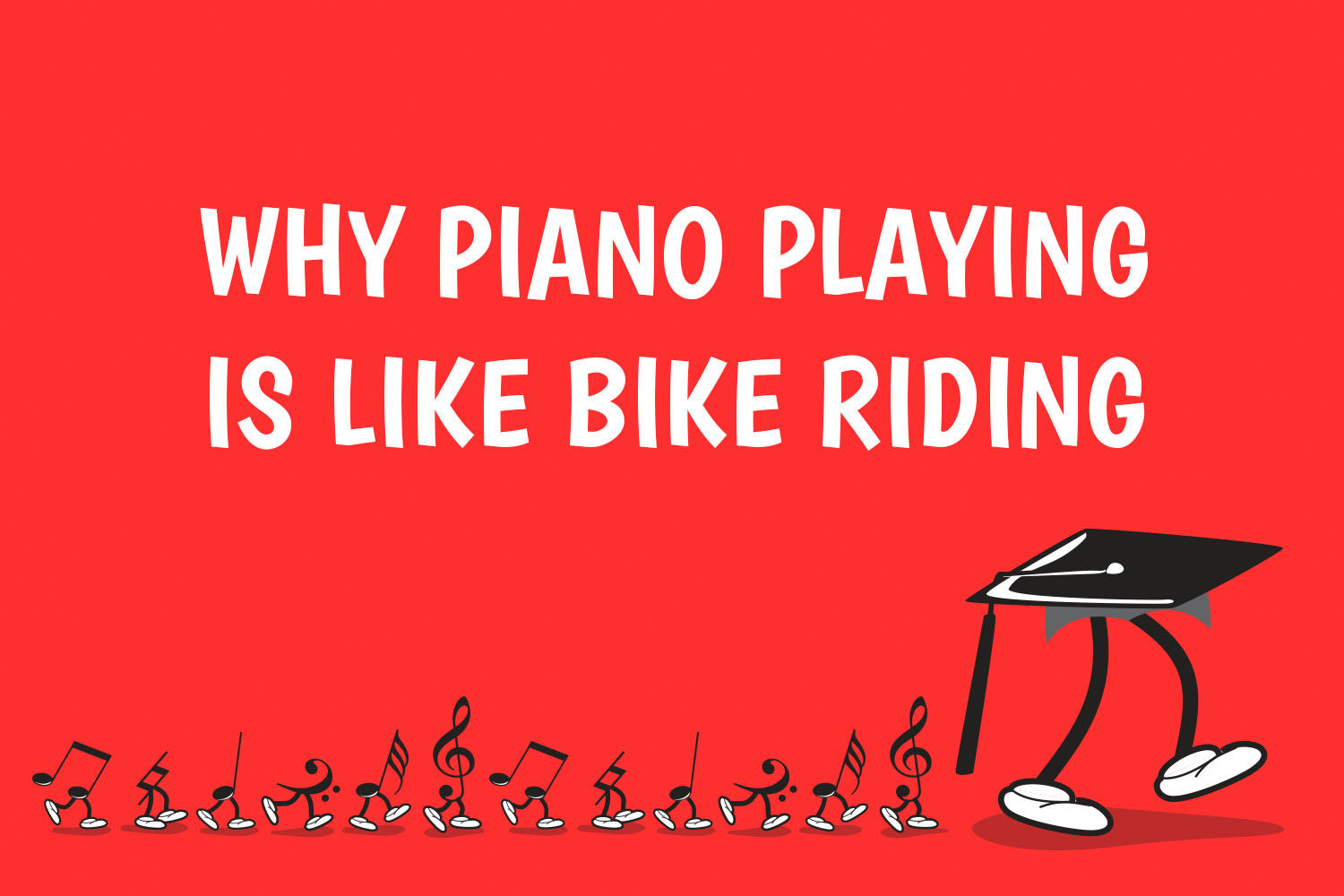Why Piano Playing is Like Bike Riding

Ok, so this probably sounds like a very far-fetched analogy, right? But I’ve been thinking a lot recently about the different factors involved in riding a bike, and how similar they are to the factors involved in a successful piano playing experience.
First things first: whilst they say you never forget how to ride a bike, you can ABSOLUTELY forget how to play the piano. So that’s not what I’m getting at here. This analogy is much more to do with the process of learning and the support needed to actually get somewhere.
I’m going to deal with three factors in each activity: parents, practice, and experts.
The Parents
– Bike Riding
Parents teach their kids how to ride a bike by organising times to go out and do so. You cannot learn to do it without doing it, and most kids can’t teach themselves. They need mum or dad to run along behind them, holding the seat, helping them while they get their balance. When they keep falling off and lose enthusiasm, the parent ramps it up: “Come on, you can do it!”
The parent knows that the child will enjoy bike riding if they can just persevere. Eventually, kids get it and don’t need the help actually riding. But they still need to be given time to ride, sometimes to be taken to bike tracks, and they need decent bikes to ride otherwise they lose interest.
– How this relates to Piano Playing
Parents need to create opportunities to practice. Unless there is time allocated, it won’t happen! Parents need to sit with kids during practice, or at least be very involved in what’s going on, until practice becomes independent. It takes a lot longer than learning to ride a bike, but it’s the same idea: parents get the kids going to a point where they can do it on their own. If the child is struggling and is therefore reluctant to play, this is where the parent needs to give MORE support: “Come on, you can do it!” They will only enjoy piano when they can actually play it.
In this analogy, parents must realise that support will be needed for many years, not just weeks.
The Practice
– Bike Riding
Once balance is achieved, it’s a matter of pedalling and steering. If kids don’t pedal, they don’t go anywhere or they just fall off. Pedalling is the only way to really get going. If you pedal a lot, it’s possible to coast for a little while, but only on flat or downhill (i.e. when it’s easy). As soon as there’s a slight incline, pedalling must resume. Steering takes kids to the places they want to go. They navigate themselves where they want, they have autonomy.
– How this relates to Piano Playing
In piano playing, the pedalling is the practice time. The more you pedal a bike, the more you go places. The more you practice piano, the more you progress. Steering the bike can be seen as choosing repertoire and genres to play. Kids need to choose this; they need autonomy. Everyone will want to go somewhere different. If you stop practising, you stop progressing. If you have done heaps of practice and then stop for a little while, you can still play the pieces for a while. But this is like coasting on the bike –it doesn’t last long. As soon as there’s a difficult piece, or too much of a gap, more practice is required!
The Experts (bike mechanic/ piano teacher)
– Bike Riding
A bike mechanic keeps the tires pumped up so that the wheels go easily over different terrain. It’s much harder to pedal if the tires are flat. A mechanic also keeps the gears going and makes sure the brakes are working, and that the steering is aligned. All of this makes bike riding a lot easier and it means that the effort put into pedalling really pays off. Having no mechanic means that pedalling might be a bit counterproductive. Doing no pedalling or steering means there is nothing for the bike mechanic to actually do.
A note about the actual bike: if it is a really cruddy bike, the child won’t enjoy riding it.
– How this relates to Piano Playing
In this analogy, the bike mechanic is the teacher. The student needs to pedal lots between lessons, but then once a week the teacher pumps up those tires to generally facilitate progress. The teacher helps the student with their steering, providing expert advice with repertoire. The teacher sees when the brakes aren’t working too well.
The real crux is this: If there is no practice, there is no progress between lessons. The bike is in the same place; the teacher tweaks a few things here and there but there is really nothing much to do in the lesson. It’s like having a lesson in the same place every week, never moving forward.
A note about the actual piano: if it is a really cruddy piano, it won’t be an enjoyable experience to play it. They do need a decent instrument otherwise enthusiasm will wane.
Now, to stretch the analogy just a little further (I mean, we’ve come this far, so why not?) here are two other bike riding concepts and how they relate to piano playing
Training Wheels
This is a way of parents not having to be there when their children are riding. There is pedalling going on for sure, but the riding is not that interesting. Eventually, those training wheels have to come off and there is a period where kids feel wobbly and need to get their balance. How does this fit into the analogy? There are a few different ways to look at it, but I like to think of this as the ‘honeymoon’ period at the beginning of learning piano. It’s a very steep learning curve and kids often gravitate to the keyboard without parents having to ask, and the parent thinks ‘oh wow they’re so keen!’. Then, the training wheels come off and support is needed. In the absence of this support and help, kids fall off and lose interest. They don’t want to ride their bikes anymore (without the training wheels). Imagine if parents said ‘oh well he’s obviously not keen on riding a bike, so we’ll stop that activity’. This happens SO OFTEN with piano. Do not mistake a child who doesn’t want to practice for a child who doesn’t want to play the piano.
Coasting
You’ve pedalled furiously and now you can sit back, relax and enjoy the ride. But only while it’s downhill, or flat… as soon as there’s a hill, you have to pedal again! In this analogy, coasting is the equivalent of playing pieces through and not practising much, if at all. When you have a LOT of practice under your belt you can get away with doing less for a while. But only if the pieces are easy (downhill) or moderate (flat). Soon that lack of practice will catch up on you, and you’ll have to start again (uphill)!
In conclusion
This analogy is working extremely well with my students and their parents. They have all experienced learning to ride a bike and parents know what it is like to help their kids on their way.
For the parents in the piano playing scenario, it’s a matter of understanding that the support needed is over YEARS rather than days/weeks.
Students really get it: they know that if they don’t pedal their bikes, they don’t go anywhere. They are really starting to understand that it will be worth that hard work in the long run!

Brilliant!
Thanks Tanya!
Great post. Thanks so much Samantha !!
Thanks Maggie!
Love this! Especially the analogy of teacher being bike mechanic, pumping up tyres once a week to help progress!
Thanks Julie. Although personally, I can’t pump up an actual tire to save my life! 🙂
This is awesome! I want all my piano parents to read this.
Thanks Samantha for your insights!
You’re so welcome Beverley!!! 🙂
This is the best! I can’t wait to share it with my students and parents! Might even think up a Bike incentive to kick start the teaching year in September. Thank you!!
A pleasure Carol!
Ooh if you do could you please share?
I love this post, Samantha! Your analogies are excellent 🙂
Thanks Brenda 🙂
This post is fantastic! You clearly have a deep understanding of what is actually required of the learning process. My 9 year old daughter is from the generation who believe that anything you need to know can be “downloaded” in an instant and so not much is ever required of her. Learning the piano is teaching her that this skill is only going to be achieved with perserverence on her part and teaching me that I need to be there for the journey right along side her.
Totally agree Carmel!!
What a refreshing approach!!
Thank you Samantha.
I shall be introducing the comparison into my teaching and to all my support parents to keep them motivated.
Thanks Frances!
Fabulous analogy!
Thanks Yvette! 🙂
Creating the opportunities to practice and then being there to support until the practice becomes independent. Wiser words were never said.It takes many hours to build any proficiency but once you got it… well, you got it. Thanks for sharing.
Thanks for the lovely feedback!
This is fabulous! I’m a bicyclist so it is all the more fitting! I’m going to share with my families!
Thanks Karen!
As an avid cyclist myself and passionate music teacher, I use bike riding frequently as an analogy.
I will now add this to my kit bag. Thankyou.
That’s great, and you’re welcome!
Hi Samantha n Nicola.
What a very clear presented helpful session…Great connections with biking n baking…skills we all acquire at varying levels of success, use and fun in life.
In my years of teaching piano, to get children to look at music and not fingers, I often refer to bike riding, where are your eyes looking? At the road ahead not your legs and feet!lol! Our legs know what to do, and same as fingers, we teach them where to be, and look ahead for music flow.
All so true Lynne! Thanks for coming to the webinar
very clever! Thanks! Enjoyed the webinar with Nicola. I like what you said about practice not sounding good. They have to know how to practice. I have a whole series called “Playing is Not Learning”.
Sounds excellent!